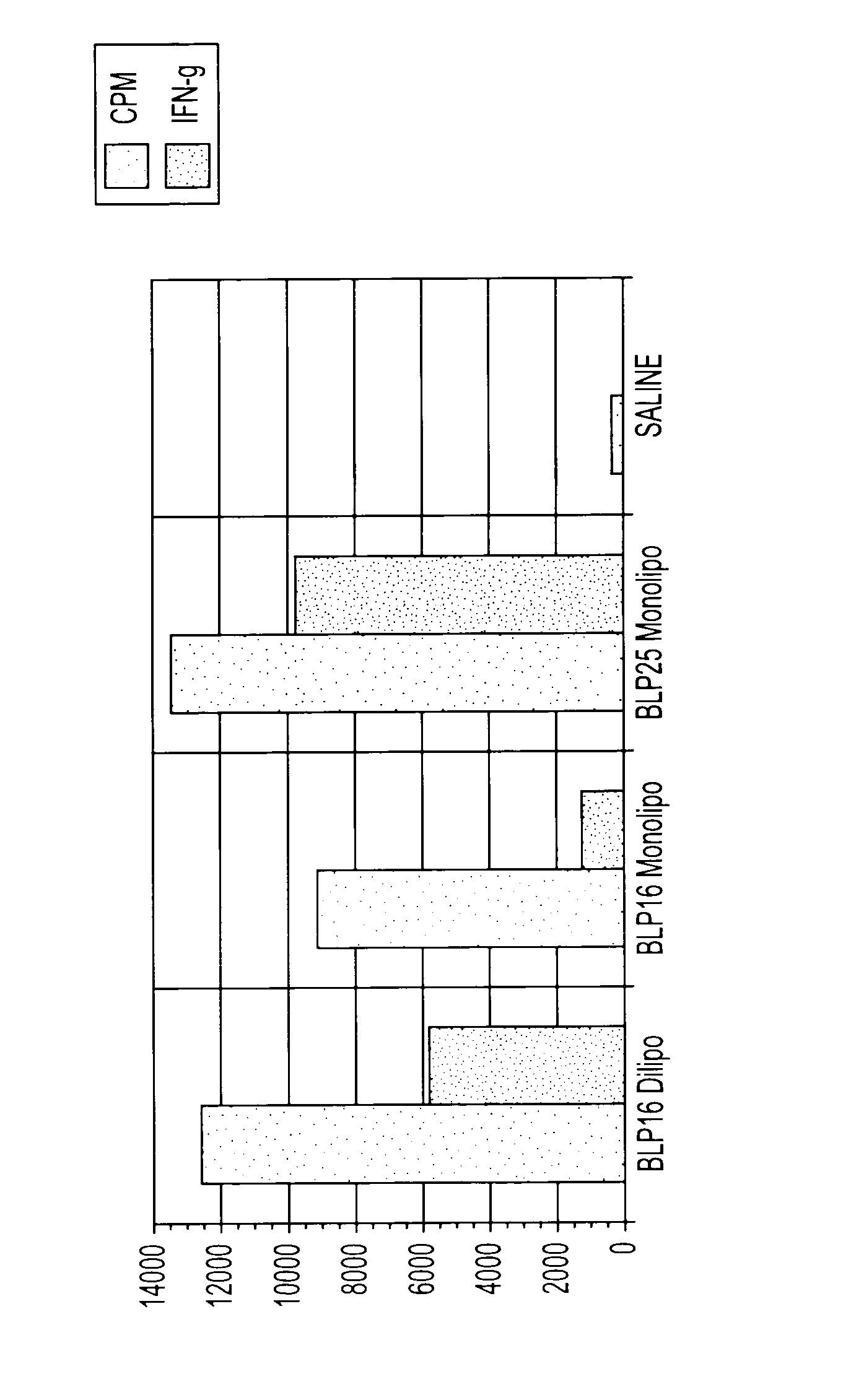Vaccine for modulating between T1 and T2 immune responses
a technology of immune response and vaccine, applied in the field of liposomal vaccine, can solve the problems of negating the usefulness of actual vaccine, invoking relatively weak immunogenic response, and none of these advances assisting in modulating one immune response to another, so as to induce multiple immune responses in individuals, modulate an immune response, and modulate the intensity of an immune response
- Summary
- Abstract
- Description
- Claims
- Application Information
AI Technical Summary
Benefits of technology
Problems solved by technology
Method used
Image
Examples
example 1
[0059]The purpose of this example was to determine the T-cell proliferation response and the Anti-MUC-1 antibody levels in response to administration of a MUC-1 antigen liposomal vaccine.
SUMMARY OF PROCEDURES USED
(i) Immunization
[0060]MUC1 based liposomal vaccines (“BLP25 liposomal vaccines”) at a dose of 100 μg (250 μl) was injected subcutaneously, two, three, or four times, at biweekly intervals, into right and left inguinal regions (125 μl per each site).
(ii) T-Cell Proliferation Assay
[0061]Nine days after the last immunization with BLP25 liposomal vaccine all mice were sacrificed and lymph nodes were surgically excised. Nylon wool purified lymph node T cells were then cultured with antigen presenting cells (APCs), which were obtained from the spleens of naïve mice of the same strain and treated with mitomycin C. These mixed cultures were pulsed with MUC1 derived synthetic lipopeptide (BP1-148) and control peptide (BP1-72) for four days. After the fourth day, some supernatants we...
example 2
Mono- and Dilipidated MUC I Antigenic Peptides
[0065]The purpose of this example was to demonstrate that a liposomally-bound MUC I peptide with two lipid chains dramatically increases the production of anti-MUC I antibodies in immunized mice as compared to a MUC I peptide with one lipid.
[0066]MUC I peptides were chemically synthesized to contain one or two lipids. “BP1-217” (SEQ ID NO: 5) has two liposerine residues attached at the carboxy terminus of the core peptidic sequence and “BP1-228” (SEQ ID NO: 6) has only one liposerine attached to the carboxy terminus. The monolipopeptide and dilipopeptide were separately incorporated into liposomes and the resultant liposomal formulations were evaluated as vaccines.
BP1-217: GVTSAPDTRPAPGSTAS(myristyl)S(myristyl)L
BP1-228: GVTSAPDTRPAPGSTAS(myristyl)L
[0067]After at least two subcutaneous immunizations of C57BL / 6 mice with the dilipopeptide liposomal vaccine, BP1-217, induced the T2, humoral response, producing very high levels of anti-MUC I...
example 3
Mono- and Dilipidated Tuberculosis Peptides
[0079]As was observed for MUC I monolipo- and dilipopeptides, immunization with dilipo-tuberculosis peptide dramatically increased antibody production. Table 4.
[0080]
TABLE 4Immune responses in C57BI / 6 mice immunized two times withtuberculosis lipopeptide based liposomal vaccinesT cellIgGIgMproliferationIFN-gTBTBVaccine(CPM)SI(pg / mL)dilipopep*dilipopep*TB Dilipo3506413.29769 1 / 218,700 1 / 900TB Monolipo1950116.22276 1 / 24,000Saline6330.6495*TB dilipopeptide DQVHFQPLPPAVVKLSDALIK (SEQ ID NO: 2) was used as a solid phase in ELISA assay.
[0081]Two immunizations with dilipo-tuberculosis peptide increased the level of IgG titers dramatically as compared to titers that were induced after immunizations with monolipo-tuberculosis peptide. The results indicate that the presence of two lipids increases the titer that correlates to a humoral response by almost 10 times.
PUM
| Property | Measurement | Unit |
|---|---|---|
| diameters | aaaaa | aaaaa |
| diameters | aaaaa | aaaaa |
| size | aaaaa | aaaaa |
Abstract
Description
Claims
Application Information
 Login to view more
Login to view more - R&D Engineer
- R&D Manager
- IP Professional
- Industry Leading Data Capabilities
- Powerful AI technology
- Patent DNA Extraction
Browse by: Latest US Patents, China's latest patents, Technical Efficacy Thesaurus, Application Domain, Technology Topic.
© 2024 PatSnap. All rights reserved.Legal|Privacy policy|Modern Slavery Act Transparency Statement|Sitemap

